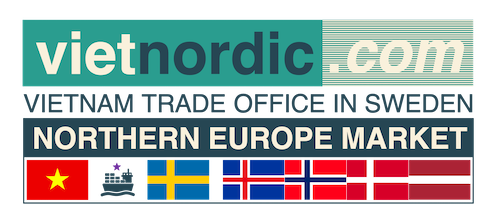The retaliatory tariffs imposed by the United States on imported goods are creating both opportunities and challenges for Vietnamese exports to Northern European markets.
Favorable exchange rates enhance Vietnamese products’ price competitiveness
Speaking with Industry and Trade Newspaper on the morning of April 4, Ms. Nguyen Thi Hoang Thuy — Director General and Head of the Vietnam Trade Office in Sweden, concurrently covering Northern Europe — stated that on April 2, 2025, U.S. President Donald Trump announced a large-scale package of retaliatory tariffs on imports from over 100 countries, with the European Union (EU) facing a 20% tariff.
Ms. Thuy highlighted a notable positive development: the exchange rate has shifted favorably for Vietnamese goods. Specifically, the U.S. dollar has depreciated while the Swedish krona has strengthened, with the current exchange rate at 9.85 SEK/USD — the highest since June 2022. This means that Vietnamese goods priced in U.S. dollars have become cheaper for Swedish consumers, enhancing their price competitiveness.
However, the extent to which this advantage materializes depends on Vietnamese businesses’ ability to maintain stable prices without raising USD-denominated selling prices. Certain sectors such as textiles and garments, footwear, seafood, wooden products, and handicrafts must remain cautious. These industries have thin profit margins and are highly sensitive to fluctuations in material costs, logistics expenses, and consumer demand. In the context of rising inflation across Europe and Northern Europe, consumers are tightening their spending, potentially leading to reduced orders or price pressure on non-essential or low-value-added goods.
Therefore, despite the favorable exchange rate, Vietnamese businesses must proactively control costs, maintain stable prices, and simultaneously enhance product quality and standards to sustain and expand their market share in high-end markets like Northern Europe.
Heightened competition from Asian countries redirecting exports to Europe
Alongside the aforementioned opportunities, Ms. Thuy noted that as access to the U.S. market becomes more challenging, China, Cambodia, Bangladesh, and many other Asian countries are redirecting their exports to the EU and Northern Europe — markets that maintain open trade policies and high consumer demand.
For instance, China could expand its presence in electronics, home appliances, and mechanical sectors in Europe. Bangladesh and Cambodia — major competitors in the textile sector — may ramp up exports of low-cost goods to the EU. Competition will not only come from lower prices but also from faster delivery times, flexible order fulfillment capabilities, and compliance with the EU’s stringent standards.
“In the midst of rising trade barriers and protectionism, the EU-Vietnam Free Trade Agreement (EVFTA) serves as a strategic shield, helping Vietnamese goods maintain their foothold in Europe,” Ms. Thuy emphasized. She further pointed out that sectors benefiting directly include textiles and garments, footwear, seafood and processed agricultural products, wooden goods, handicrafts, and electrical and electronic equipment.
Especially in Northern Europe — where consumers prioritize sustainable, eco-friendly, and transparent products — Vietnamese companies can enhance their competitive edge by investing in certifications such as eco-labels, traceability systems, and carbon footprint verification.
Ms. Thuy further assessed that the new U.S. tariff policy, though a major challenge, also presents an opportunity for Vietnam to diversify its markets and reduce reliance on the U.S. and short-term orders. It is also a chance to transition from competing on price to competing on quality, sustainability, and traceability. She urged businesses to invest in meeting European standards like eco-labeling, carbon footprint certification, and CSR credentials to build consumer trust in Northern Europe. Moreover, optimizing EVFTA benefits and positioning Vietnamese goods as a “reliable alternative” in global supply chains is crucial.
“The U.S. retaliatory tariffs are triggering systemic disruptions in global trade, potentially leading to widespread recession and disruption,” Ms. Thuy pointed out. “While major countries are still debating their responses, Vietnamese businesses need to adapt early and proactively.”
Thanks to political stability and the EVFTA cooperation framework, the EU and Northern Europe are emerging as strategic gateways for Vietnamese exports. The key is not merely to “weather the storm,” but to seize the opportunity to reposition Vietnamese products on the global trade map — not only as affordable but also as high-quality, sustainable, and reliable.

